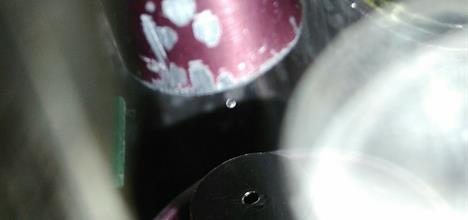Air pollution doesn't come solely from car exhausts and fossil fuel power stations; another key component are tiny droplets of oils given off from, amongst other things, cooking. The presence of these fatty acids may add to the pollution of our environment.
Almost all fatty acids in the urban atmosphere are there through human activity, e.g.; being released from oil and fats during cooking. So, understanding how long they last in the atmosphere, and how far they spread to different places, is important to controlling their impact.
Levitating Droplets

The research team from Birmingham and Bath are able to study aerosol droplets using acoustic levitation. That is, using sound waves to 'trap' a single millimetre sized droplet over several hours.
In collaboration with Dr Andy Ward, from the CLF Octopus facility, a laser-based Raman microscope was combined with acoustic levitation for use on the I22 beamline at Diamond Light Source (UK). Installing the system on the beamline at Diamond allowed the Raman technique to be used simultaneously with Small-Angle & Wide-Angle X-ray Scattering.
Dr Ward says, “Being able to collaborate with our colleagues at Diamond has added another dimension to this work. Accessing both real-time chemistry and structure is such a powerful technique to study these materials."
The dual technique allowed the researchers to understand the physical and chemical changes that take place in aerosol droplets under changing humidity, and changing concentrations of ozone.
Using oleic acid droplets as a model, the research showed that a surface layer of crystal- like material formed, a crust - imagine the chocolate around the soft centre of a Crème Egg.
The fatty acid aerosol particles in the atmosphere are normally degraded mainly by oxidation. They react with hydroxyl radicals, nitrate radicals, and ozone, which eventually destroy the fatty acid.
The crust this research found forms around the droplets can protect the fatty acids from oxidation, and allow them to survive for longer in the atmosphere. The longer they survive for, the further the droplets can travel on air currents. This crust can also protect other harmful chemicals in these droplets from being broken down by oxidation, so they survive longer and travel further, too. This is an important result because it shows that air pollution can travel long distances from the location where it was produced, potentially impacting larger areas of the atmosphere and environment than would be the case otherwise.
Read More
You can read the full paper at https://acp.copernicus.org/articles/21/15003/2021/ and find out about previous work which this builds on at https://www.clf.stfc.ac.uk/Pages/Cooking-oil-emissions-polluting-urban-environments-.aspx.
